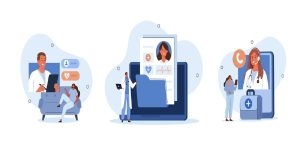You’d think going digital would solve all our problems, right? Well, not quite. Electronic Healthcare Records Software has changed how doctors and nurses work, but it’s brought its own set of headaches. Just last week, a nurse spent fifteen minutes trying to find a patient’s allergy information that would’ve taken seconds with paper charts.
The truth is, while these systems promise to make healthcare better, they’re creating new problems that nobody talks about. Let’s dive into the real challenges healthcare workers face every day when dealing with digital records.
The Learning Curve That Never Ends
Learning new software isn’t just a one-time thing in healthcare. Staff members constantly struggle with updates, new features, and different systems across departments. The challenge goes beyond basic computer skills. It’s about mastering complex medical software while still focusing on patient care.
Training Takes Forever
Here’s what nobody tells you about Electronic Healthcare Records Software: it’s like learning a new language every few months. Healthcare staff already work long hours, and now they need to master complex software too.
- New employees need weeks of training before they can work independently
- Software updates change everything you just learned
- Different departments often use different systems
- Older staff members struggle more with technology
Dr. Akansha from our local clinic told me she spent three months just getting comfortable with her new system. That’s three months of slower patient care and frustrated staff.
The Interface Confusion
Ever tried to find something on a website that’s poorly designed? That’s what many healthcare workers deal with daily. The software interfaces are often confusing and take too many clicks to do simple tasks.
Technical Problems That Disrupt Patient Care
Technology failures in healthcare aren’t just inconvenient – they can be dangerous. When systems crash or run slowly, medical staff can’t access critical patient information. These technical issues happen more often than most people realize, creating stress and delays in patient treatment.
When Systems Crash?
Picture this: you’re in the middle of treating a patient, and suddenly the system freezes. No access to medical history, no way to check medications, nothing. This isn’t rare; it happens more often than you’d think.
- Server crashes can last hours
- Internet problems shut down cloud-based systems
- Software bugs cause unexpected errors
- Backup systems aren’t always reliable
Healthcare providers such as MargBooks have seen firsthand how technical failures can delay treatments and stress out medical teams.
Slow Performance Issues
Nothing’s more frustrating than waiting for a slow computer when patients are waiting. Many Electronic Healthcare Records Software systems run slowly, especially during busy hours.
- Pages take forever to load
- Searching for patient records becomes a waiting game
- Multiple users slow down the entire system
- Old hardware can’t keep up with new software demands
Data Security and Privacy Concerns
Healthcare data is extremely valuable, making medical facilities prime targets for cybercriminals. Patient records contain sensitive personal and medical information that must be protected. The digital shift has created new security challenges that healthcare providers must constantly address.
Cybersecurity Threats
Healthcare data is valuable, and hackers know it. Medical records contain everything from social security numbers to detailed health information. This makes healthcare facilities prime targets for cyberattacks.
- Ransomware attacks can shut down entire hospital systems
- Data breaches expose sensitive patient information
- Staff need constant training on security protocols
- Compliance requirements are strict and complex
Patient Privacy Worries
Patients worry about who can see their information. With digital systems, more people have access to records than ever before. This includes:
- IT staff who maintain the systems
- Third-party vendors who provide support
- Insurance companies that process claims
- Government agencies that audit records
Companies like MargBooks work hard to address these privacy concerns, but patients still feel uneasy about digital storage.
Integration and Compatibility Issues
Most healthcare facilities use multiple software systems that don’t communicate well with each other. This creates data silos where important patient information gets trapped in different systems. The lack of seamless integration forces staff to work harder and increases the risk of errors.
Systems That Don’t Talk to Each Other
Here’s a common problem: your hospital uses one system, but the lab uses another. The pharmacy has its own pharma billing software, and the billing department uses different software. None of these systems communicate well with each other.
- Patient information gets trapped in different systems
- Medical staff waste time entering the same data multiple times
- Important information gets lost between departments
- Coordinating care becomes much harder
Switching Between Systems
Healthcare workers often need to use multiple programs throughout their day. They might check patient records in one system, order tests in another, and handle billing in a third. This constant switching slows everything down.
MargBooks has noticed that healthcare facilities struggle most when they have too many disconnected systems running at once.
Cost and Budget Concerns
The financial burden of Electronic Healthcare Records Software extends far beyond the initial purchase price. Healthcare facilities often discover unexpected costs that strain their budgets. Many organizations struggle to justify the expense when the promised benefits don’t materialize as expected.
Hidden Expenses
The sticker price of Electronic Healthcare Records Software is just the beginning. Hidden costs include:
- Ongoing maintenance and support fees
- Training costs for new staff
- Hardware upgrades needed to run the software
- Downtime costs when systems fail
Return on Investment Questions
Many healthcare facilities wonder if they’re saving money. While digital systems promise efficiency, the reality is often different. Staff spend more time on data entry and less time with patients.
MargBooks research shows that smaller clinics especially struggle to see financial benefits from their EHR investments.
Impact on Patient-Doctor Relationships
The doctor-patient relationship has changed dramatically since electronic records became standard. Healthcare providers now spend more time looking at screens than at their patients. This shift affects communication, trust with our online billing software, and the overall quality of medical care that patients receive.
Less Face-to-Face Time
Remember when doctors looked at you during appointments? Now they’re often staring at computer screens, typing notes, and clicking through menus. This changes the entire dynamic of healthcare visits.
- Patients feel ignored or rushed
- Doctors miss important visual cues
- The personal connection suffers
- Medical consultations feel more mechanical
Documentation Overload
Doctors now spend hours each day on documentation. They’re required to enter detailed notes for every patient interaction, often staying late to catch up on paperwork that used to take minutes.
Conclusion
Our electronic healthcare records software was supposed to make healthcare better, but it’s created new challenges that affect everyone involved. From technical problems to privacy concerns, from training headaches to relationship issues between doctors and patients, these systems have a long way to go.
While companies like MargBooks continue working to improve these technologies, healthcare workers are stuck dealing with the current problems every day. The key is finding solutions that make life easier for medical staff while keeping patient care as the top priority. Until then, the struggle continues in hospitals and clinics everywhere.



